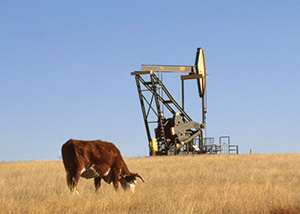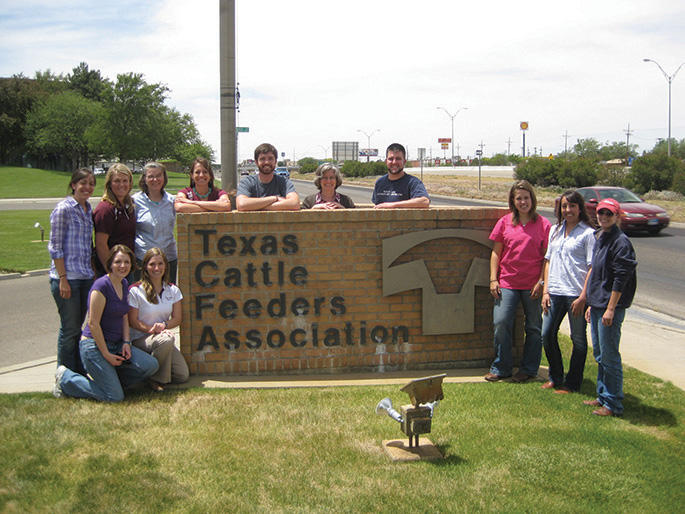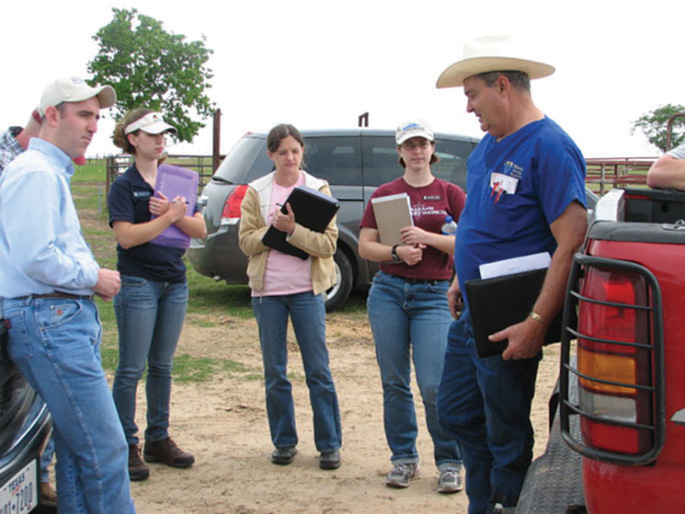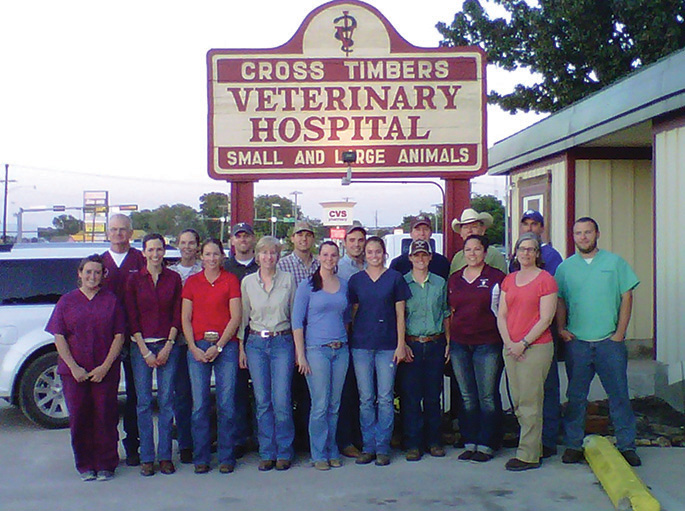Serving the Texas Agriculture Industry; From College to Career

Texas is not only the largest of the 48 contiguous United States, but also the nation’s leading producer of beef. In 2012, the beef cattle industry accounted for just over half of the $20 billion in America’s agricultural cash receipts at $10.5 billion. Beef cattle production also accounted for $855 million in exports to foreign countries in the same year. Protecting and ensuring the health and welfare of beef cattle as part of the food supply and as an economic driver in Texas presents a challenge and an opportunity for the Texas A&M; College of Veterinary Medicine & Biomedical Sciences (CVM), the only college of veterinary medicine in the state.
A Productive Tour
Cognizant of their responsibility to educate the next generation of veterinary practitioners to serve the state of Texas and the animal agriculture industry, faculty members at the CVM began developing new and innovative ways to expose interested students to production veterinary medicine. One of the ongoing challenges in providing new experiences for students is the constraints of an already packed four-year curriculum. In 2008, Dr. Virgina Fajt, clinical associate professor in the Department of Veterinary Physiology and Pharmacology, and Dr. Dan Posey, director of student affairs and clinical associate professor in the Department of Large Animal medicine, found a solution that extended the reach of the CVM across Texas and helped form partnerships that directly influence the animal agriculture industry. That effort, the Food Animal Production Tour, a one-credit elective for first and second-year veterinary students, has been critical in demonstrating career options that students may not have known were available.

“We recognized that there are populations of food animals that are close to the veterinary school the students get to see, like cow/calf and some stocker operations, a few small swine operations, and certainly harvest facilities,” said Fajt. “However, the majority of the large operations are in the Texas Panhandle. We are trying to look for ways to attract students who have an interest in food animal, but aren’t getting exposed to those types of production units in the local area.”
The elective tour takes 10–11 students with two faculty members to the Texas Panhandle and into Oklahoma. Over the course of the week-long trip, the group visits veterinary practices in the region that service the production industry. These veterinarians also host the students at their clients’ enterprises, demonstrating to the students the relationship between the producer and the producer’s veterinarian.
“We have worked every year with practices focused on food animal,” said Fajt. “These are production-oriented practices. We have, in the past, showered into a swine facility and learned about biosecurity from their perspective. We try to visit a harvest facility of some kind. We have also had the opportunity to visit with the Texas Cattle Feeders Association in Amarillo, so the students get to see the organized industry side of things in addition to just the production side of things. Students get the full breadth of where veterinarians get involved and what food animal production looks like from the beginning to the end.”
Recent data have shown that while there may not a shortage of food animal veterinarians, there will always be a need to develop the next generation of veterinarians who have the passion and skills for working in the production industry. Posey noted that the average age of veterinarians working in production medicine is between the mid-50s to early 60s, indicating a need for a whole new group of veterinarians to serve the food animal industry. However, one of the most interesting opportunities, from Posey’s perspective, is watching the progression of students from the classroom to the feedlot consultation.
“It’s really interesting,” said Posey, “when you start looking at most of the veterinarians who are in the feedlot industry. They actually start out as mixed animal practitioners, and some of them still have those practices in addition to serving the large producers in their area. Their careers actually started here in the college and they end up in industry because of what they have learned in rural practice, and then they go on. So it often has to be a progression from practice to production, because it takes a really deep skill set to be a feedlot veterinarian.”
The Food Animal Production Tour elective is able to accommodate only 10–11 students due to cost and to avoid disrupting the operations and practices they visit. At the end of the elective, the students have to do a project that enables them to extend what they learned on the tour and to share it with the rest of their class of veterinary students. Posey and Fajt said these projects have taken the form of posters, presentations, and even workshops with guest speakers. The projects are not necessarily large, but they emphasize to the students on the tour the importance of sharing knowledge and providing insight into the production industry that others may not have.
“We had one group of students who attended a presentation at a feedlot on low-stress handling of cattle,” said Posey. “Tom Noffsinger, a veterinarian in Nebraska, was presenting a seminar to feedlot employees. Our students turned around and had him come to Texas A&M; to expose all the other students to his message, about how we need to handle cattle differently than the way most of us were trained.”
Close to 132 students attended that seminar to watch him talk about how cattle think when moving in a structure, how to keep them in a chute, and how to handle them in a safe and stress-free way. In conjunction with this presentation, the students organized a beef quality assurance workshop for those that attended.
Over the years, the number of students who have expressed interest in food animal medicine has been relatively low. Posey stated that out of a class of veterinary students at Texas A&M;, only about 35–40 students will choose to go into mixed animal practice, with the majority of those being companion animal oriented practices versus food animal practices. The Food Animal Production Tour helps to show these students who are leaning toward mixed or food animal practice, that there are a number of career options available.
Growing Relationships

In addition to being an important educational opportunity for students, the tour has become a significant part of the CVM’s outreach efforts to provide ongoing and improved support of the animal agricultural industry. These efforts have created valuable partnerships that reach across the state.
“We continue to develop relationships across the entire state of Texas,” said Fajt. “Veterinary medicine covers the entire state of Texas. We may be some distance away from the large production facilities, but we want to address whatever their needs are; we want to know what they need. We continue to talk to each other about issues. We can’t do things in isolation, so we need to continue the conversations.”
One of the partners that has contributed to the tour is Texas Cattle Feeders Association (TCFA). Fajt and Posey acknowledged that many students, even those interested in food animal medicine, are not aware of this organization, or of how they support the production industry, the kind of education they provide for members, and the legislative agenda they advocate on behalf of the beef industry.
“We actually take our students to TCFA so they see the things that TCFA does for the industry, like the welfare audits offered to their members,” said Posey. “It’s a really, really important part in the beef industry to understand that part of it, because most of our students have never been exposed to that side, the non-medical side, and it’s opening their eyes to the possibility of a job somewhere to serve the state of Texas.”
The relationship between the CVM and the food production industry began over 100 years ago, as the CVM was born out of the Texas cattle industry. The Food Animal Production Tour helps maintain that relationship, while enriching the CVM curriculum. The faculty within the food animal section of the CVM recognize the need to include more information about production medicine into already established courses.
“We have faculty members who are both members of and serve on committees and boards of organizations like the National Cattleman’s Beef Association, the Texas and Southwestern Cattle Raisers, Texas Cattle Feeders Association, and similar organizations,” said Dr. Meredyth Jones, assistant professor in food animal field service at the CVM. “Their meetings and conferences are centered around dealing with the most current issues that are impacting their industry. By having a presence at these meetings and serving on these committees, we are aware of those issues most important to the producer and to the beef industry as a whole. We can then bring this back to share with other faculty and our students, so they become more aware of what is happening in this field that could potentially impact them as practitioners.”
Jones noted that producers have often viewed veterinarians as doctors who fix broken animals and who are concerned only with sick animals. By engaging producers and industry leaders, Jones said, the CVM can be a leader in changing that opinion and showing that veterinarians possess the skills to understand production animal health concerns and contribute to solutions in individual operations and the entire industry.
“We, as a faculty, feel it’s very important not only to expose our students to the current trends in the food animal industry, but also to let industry know that we are interested in more than just the individual animal,” said Jones. “We do understand that there is a population out there and an industry that goes along with that ‘sick cow’ that we’ve traditionally dealt with.”
As part of growing the relationship with the food animal industry, the faculty within the CVM have committed to being leaders. In addition to attending industry meetings, Jones said it is important for the CVM to take a lead role in bringing information back to producers that impacts the way they do business and in disseminating information to students, producers, and ranchers.
“While students are still here in college,” said Jones, “they tend to focus on their own veterinary world. It’s our job to keep reminding them of the end goal-that we are going to teach you a lot of anatomy, physiology, and treatment, but you need to understand the industry you are going to serve.”

According to Jones, the Food Animal Production Tour has been a great step in building that understanding for students. It provides that opportunity to take students out of this geographic area and show them the industries that have the largest impact on the Texas economy. However, she also notes that students would benefit more from longer-term educational opportunities, and that is what the CVM is working to develop.
“Other things we have looked at and are working on are more long-term educational experiences, where we would be able to send students to other parts of the state to work in large-scale production facilities for a longer period of time,” said Jones. “An example would be sending a student to live in the Panhandle anywhere from a few weeks to perhaps the whole summer. This would allow them to experience the different areas of working within the production industry from merchandising to feeding to feed manufacturing to animal health. They could also interact with the veterinary diagnostic lab located in Amarillo and experience the different aspects of that operation.”
Although the Food Animal Production Tour and these additional educational experiences have been valuable to both students and the industry, they come at a cost. The expense to provide students with these opportunities is not insignificant. The faculty work continuously to identify partners and funding sources from industry and the veterinary profession that are able to offer this type of programming.
“We have some unique opportunities here,” said Jones. “We’ve got a lot of diversity in Texas and a lot of different agriculture groups that we can serve. We’re interested in finding ways to identify students who are most likely to serve those industries and get them involved as early as possible so they’re picking up really practical knowledge. We want them to have a real understanding of the industry to enhance what we believe is a really outstanding veterinary education.”


